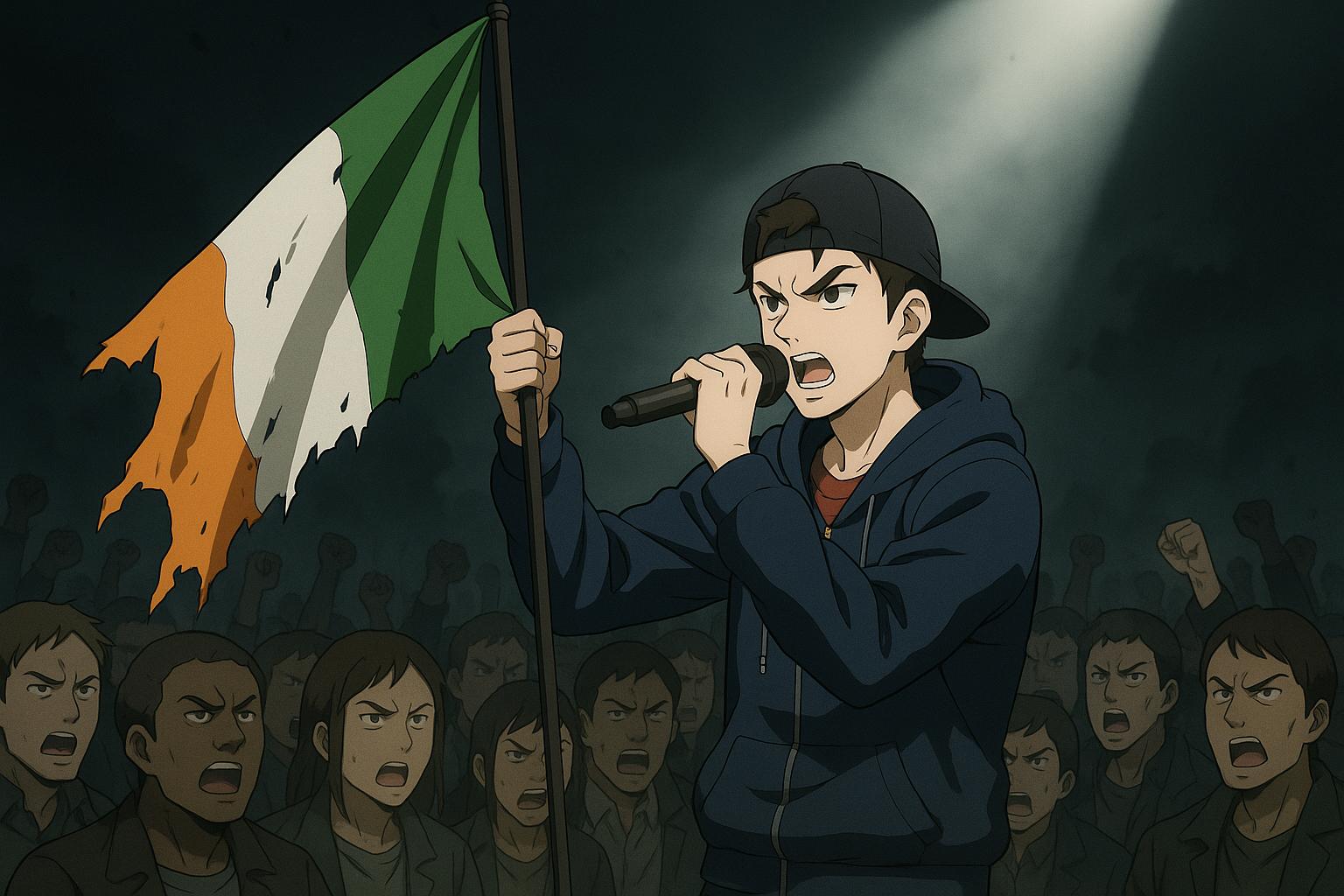Nothing incites ire within the British establishment quite like a challenge to its authority, especially when that challenge comes from an artist whose voice is not expected to resonate in mainstream discourse. Liam Óg Ó hAnnaidh, better known as Mo Chara, a member of the Irish-language rap trio Kneecap, faces significant legal challenges after being charged under the UK’s Terrorism Act for allegedly displaying a Hezbollah flag during a concert in London. This incident, which occurred in November 2024, has sparked renewed debates about free expression and the role of art in society.
Kneecap, hailing from Belfast, has built a reputation for their politically charged performances that evoke a legacy of Irish resistance and cultural identity. Their provocative style, akin to protest movements in music and art, has continually tested the boundaries of acceptable discourse in the UK. Supporters of Mo Chara interpret these charges as a blatant attempt to silence an artist whose work critiques the status quo, particularly concerning global injustices such as those in Gaza. The group has categorically denied endorsing Hezbollah or Hamas, asserting that their performances are rooted in artistic expression rather than political support for extremist causes. They have condemned all violence against civilians, positioning their messages within a framework of anti-colonial struggle.
Criticism of Kneecap has been amplified by recent controversies, including their performances at high-profile events like Coachella, where their political messaging garnered significant attention. This scrutiny appears to coincide with a pattern of increased policing of artistic expression, often targeting those who challenge narratives favoured by the establishment. Mo Chara’s situation has been likened to that of previous Irish artists who have faced backlash for their politically charged work, from Christy Moore to Paul McCartney, indicating a longstanding tradition of resistance through art.
In juxtaposition to Kneecap's plight, the hypocrisy demonstrated by certain political figures, particularly Kemi Badenoch, has not escaped public scrutiny. Recently, Badenoch has faced criticism for her perceived leniency towards Frank Hester, a major Conservative donor who allegedly made racist comments about Diane Abbott, the UK’s first Black female MP. While Badenoch distanced herself from Hester’s remarks, stating they were "clearly unacceptable," her swift response to Kneecap's artistic expressions jars with her slower reaction to Hester's incendiary comments. This disparity raises questions about whose voices are deemed acceptable and whose are labelled as threatening or undesirable.
Kneecap's case underscores a broader concern regarding the chilling effect such legal actions may have on artists, particularly those from marginalised communities. The charges against Mo Chara have been interpreted by many as indicative of a systemic effort to constrain voices that challenge dominant political narratives. The dramatic increase in public and legal scrutiny toward artists like Kneecap signals a troubling trend in which dissent is increasingly seen as a threat. The irony is not lost on observers that the same establishment that seeks to silence these voices simultaneously calls for loyalty and obedience from all sectors of society.
The very nature of their performances—a blend of art, politics, and communal identity—stands as a testament to a vibrant tradition of Irish art which is politically charged and historically rebellious. From the lyrics of legendary figures like Sinead O’Connor to the songs of contemporary artists, Irish culture has long been interwoven with themes of resistance and anti-colonial sentiment. This powerful heritage is reflected in Kneecap's work, making their indictment for purportedly provocative displays even more profound.
In essence, Mo Chara and Kneecap are more than mere performers; they represent a voice that resonates with many who feel alienated by the political landscape. As they prepare for their court appearance, the eyes of the artistic community and society at large are firmly upon them, recognising that the outcome of this case may have far-reaching implications for artistic freedom and the right to dissent against a backdrop of political power.
If the British establishment wishes to maintain any semblance of credibility, it would do well to remember the history that has shown time and again that efforts to silence dissent merely amplify its message. As Kneecap continues to champion a narrative that calls out injustices, the louder their voices are likely to grow, ensuring that the true issue lies not within their art, but within a system fearful of what that art might reveal.
Reference Map:
- Paragraph 1 – [1], [2]
- Paragraph 2 – [1], [3], [4]
- Paragraph 3 – [1], [5], [6]
- Paragraph 4 – [1], [2], [3]
- Paragraph 5 – [2], [4], [6]
- Paragraph 6 – [1], [3], [4]
- Paragraph 7 – [1], [2], [6]
- Paragraph 8 – [1], [2], [3]
- Paragraph 9 – [1], [4], [5]
- Paragraph 10 – [1], [2], [4]
Source: Noah Wire Services
